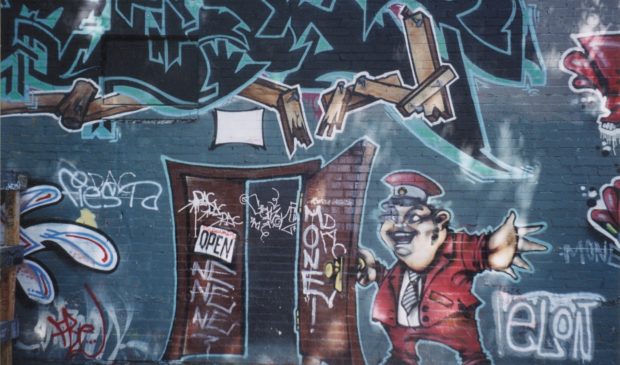City looks to clean up graffiti program
Thursday, May 25, 2017 by
Jack Craver A program that was originally intended to help at-risk youth gain job skills has evolved into a city-funded graffiti clean-up service that is doing the work that should be left to private property owners.
“It’s a great program and we want to keep it,” said Interim Assistant City Manager Sara Hensley about the Austin Youth Development Program, which employs up to 15 people between the ages of 17 and 22. “But it kind of turned into this graffiti-busters program. It grew into something that per ordinance was never permitted.”
Indeed, for more than two decades city ordinance has clearly stated that private property owners are responsible for addressing vandalism of their buildings within 30 days.
And yet, while the Austin Public Health’s website notes that responsibility and describes the graffiti abatement program as responsible for addressing defacement of public property, it also appears to invite property owners to call and request free graffiti removal services courtesy of the youth program.
“Call 3-1-1 or download the free 3-1-1 mobile app to report graffiti on private or public property. If you do not own the property, we will contact the property owner to make arrangements for clean-up,” states the site. “The Austin Youth Development Program (AYD) employs young adults ages 17-22 to come to remove graffiti, under the supervision of City employees.”
The problem is not just that the city is assuming inappropriate responsibilities, said Hensley, but that it’s severely overburdened. The city currently has a backlog of roughly 1,400 graffiti complaints, she said, although she noted that some of the complaints are likely duplicates and that in some instances the property owner has likely already dealt with the matter. Whatever the actual number, the city has still not removed some graffiti that was reported in January.
Hensley therefore wants to kick off what she believes will be a yearlong process to raise awareness about graffiti. That means educating property owners on their obligation to remove it as well as finding avenues for graffiti artists to spray paint legally and productively.
“We want people to express themselves and we want to create a mechanism, maybe through our public arts department to seek out blank slates” where people can spray paint, she said.
In that vein, she said, it’s important to distinguish between what she calls “graffiti art,” notably work that is authorized by the property owner (e.g. “I love you so much…”) and “taggings,” which Hensley described as “unsightly” scribbling that is increasingly showing up on light posts, signal boxes and buildings.
While gang-related graffiti is often a concern among public officials, Hensley said that much of the vandalism she’s seeing likely isn’t linked to gangs. But the research is clear, she said, that graffiti makes people feel unsafe by creating the sense that laws aren’t being enforced. Taggings beget more taggings – even “competitive tagging,” in which rivals spray over their peers’ tags.
Ideally, said Hensley, Austin will put in place a program similar to San Antonio, whose website explains that the city provides a number of resources to help property owners take down taggings, including free paint and assistance for the elderly or disabled. The website also includes contact information for a number of private companies whose property is often tagged, such as telecom companies and utilities.
Hensley would like to develop a similar portal for graffiti abatement resources in Austin, where community groups could invite public officials to talk with them about prevention measures or graffiti-besieged property owners could obtain free paint through Austin Resource Recovery’s paint recycling program.
In a May 18 memo to Mayor Steve Adler and City Council members, Hensley described a multi-step process to developing a “centralized unit” to deal with graffiti. In the coming months, she and others will determine a city department that will be the “lead” on the issue as well as consult with the Code Department, the Austin Police Department and the Law Department on enforcement strategies. In addition, they will work to recruit volunteers and engage with community groups and businesses on the issue and develop a “city-wide communication strategy.”
Concluding the memo, Hensley said her goal was to get rid of the backlog by the end of the calendar year.
“This, along with a robust education campaign,” she wrote, “should help begin the New Year with a more effective approach to our graffiti challenges.”
Photo by OpalDivine – Own work, CC0, Link.
The Austin Monitor’s work is made possible by donations from the community. Though our reporting covers donors from time to time, we are careful to keep business and editorial efforts separate while maintaining transparency. A complete list of donors is available here, and our code of ethics is explained here.
You're a community leader
And we’re honored you look to us for serious, in-depth news. You know a strong community needs local and dedicated watchdog reporting. We’re here for you and that won’t change. Now will you take the powerful next step and support our nonprofit news organization?









